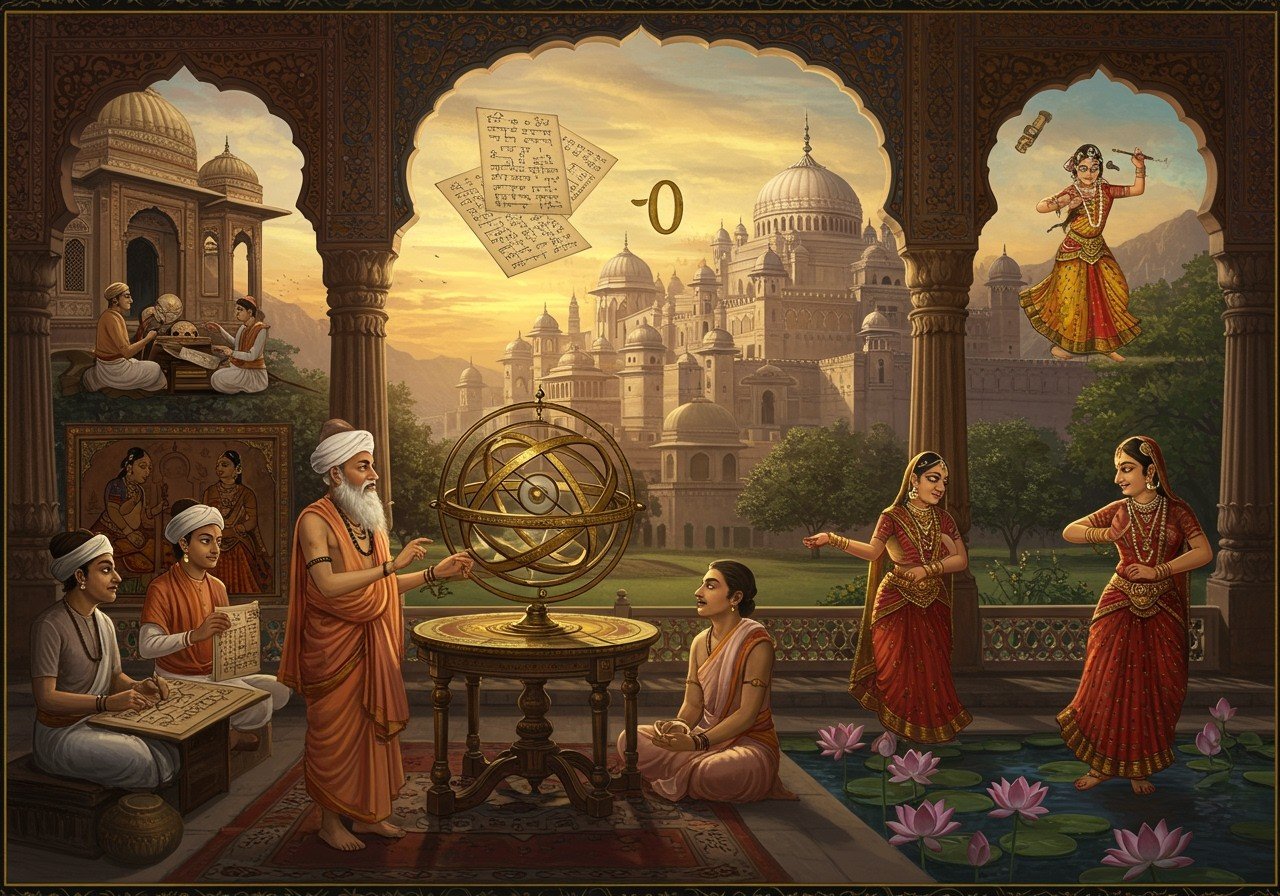
The Golden Age of India, spanning the 4th to 6th centuries CE during the Gupta Empire, represents a period of unparalleled cultural and intellectual achievements. This era significantly shaped India’s rich heritage through advancements in art, architecture, literature, and science. This blog post delves into the profound impact of this period, exploring its artistic marvels, cultural richness, and architectural grandeur.
Art in India’s Golden Age
A Remarkable Evolution in Indian Art
The Gupta period witnessed remarkable developments across various art forms:
- Sculpture: This era is renowned for exquisite stone sculptures, particularly the serene Buddha statues from Sarnath, which exemplify the artistic skill and spiritual depth of the time. These sculptures often depicted religious figures and narratives, showcasing the period’s devotion and artistic mastery.
- Painting: The Ajanta Caves house vivid frescoes depicting Buddhist themes and scenes from daily life, offering valuable insights into the period’s culture and beliefs. These paintings employed vibrant colors and intricate details, capturing the essence of the Gupta period’s artistic brilliance.
- Metalwork: The iconic Iron Pillar of Delhi, renowned for its rust-resistant properties, stands as a testament to the advanced metallurgical knowledge of the time. This remarkable feat of engineering highlights the scientific and artistic prowess of the Gupta period.
- Terracotta: Figurines and plaques from this era offer glimpses into everyday life and mythological scenes, providing valuable historical and cultural context. These terracotta artifacts depict a range of subjects, from common people to deities, showcasing the artistic diversity of the period.
- Coinage: The detailed depictions of kings and deities on Gupta coins reflect the political and religious landscape of the time. These coins serve as historical records and demonstrate the artistic detail applied even to everyday objects.
- Manuscripts: Illustrated manuscripts, such as the Bower Manuscript, offer invaluable literary and cultural insights into the Gupta period. These manuscripts preserve ancient texts and artistic styles, enriching our understanding of this era.
Gupta art significantly influenced later Indian art forms and extended its reach to Southeast Asia, leaving a lasting legacy on the artistic traditions of the region. If you’re interested in owning a piece of this rich artistic heritage, consider exploring the exquisite collection of spiritual idols and artifacts at poojn.in.
Shop Now: Exquisite Spiritual Idols and Artifacts
Culture in India’s Golden Age
Intellectual and Spiritual Advancements
The cultural landscape of the Gupta period was significantly enriched by numerous advancements:
- Literature: This era produced literary masterpieces like Kalidasa’s plays ‘Shakuntala’ and ‘Meghaduta’, showcasing the poetic and dramatic brilliance of the time. These works continue to be celebrated for their intricate storytelling and profound themes.
- Religion: The Gupta period saw the compilation of significant religious texts like the Puranas and a resurgence of Vaishnavism and Shaivism. These developments played a crucial role in shaping the religious landscape of India.
- Philosophy: Schools of thought like Vedanta and Mimamsa flourished, with contributions from scholars like Adi Shankaracharya. This period fostered deep philosophical inquiry and debate, contributing to India’s intellectual heritage.
- Education: Renowned universities like Nalanda and Takshashila became centers of learning, attracting students from far and wide. These institutions played a crucial role in preserving and disseminating knowledge across various disciplines.
- Music and Dance: Classical forms such as Bharatanatyam and Odissi evolved during this period, showcasing the artistic expression and cultural richness of the era. These dance forms continue to be performed and celebrated today, carrying forward the legacy of the Golden Age.
- Festivals: Many festivals formalized during this period are still celebrated today, demonstrating the enduring cultural impact of the Gupta era. These festivals reflect the religious beliefs and cultural practices of the time and continue to be an integral part of Indian tradition.
- Science and Technology: Significant advancements were made in astronomy, mathematics, and medicine by scholars like Aryabhata and Sushruta. Aryabhata’s work on the concept of zero and Sushruta’s contributions to surgery were groundbreaking achievements that significantly influenced future scientific thought.
To enhance your understanding and appreciation of India’s rich cultural heritage, explore the resources available on poojn.in, where you can find information about various deities and rituals.
Learn More About India’s Cultural Heritage
Architecture in India’s Golden Age
Innovation and Grandeur in Architecture
The Gupta period is renowned for its architectural achievements:
- Temples: The Nagara style of temple architecture, characterized by its beehive-shaped shikhara, emerged during this era, exemplified by the Dashavatara Temple. This architectural style became a prominent feature of North Indian temples.
- Stupas: Buddhist stupas, such as those at Sanchi, underwent expansion and embellishment with detailed reliefs, showcasing the artistic and architectural skills of the period. These stupas serve as important religious and historical landmarks.
- Cave Architecture: The elaborate rock-cut architecture of the Ajanta and Ellora caves represents a remarkable feat of engineering and artistic expression. These caves house intricate carvings and sculptures, reflecting the religious and cultural significance of the period.
- Urban Planning: Well-planned cities like Pataliputra exemplified the Gupta period’s focus on organized urban development. These cities featured well-structured layouts and infrastructure, demonstrating the advanced urban planning concepts of the time.
Conclusion
The Golden Age of India stands as a testament to the remarkable achievements in art, culture, and architecture during the Gupta Empire. This era saw the creation of exquisite sculptures, vibrant paintings, and intricate metalwork. Literature flourished, spiritual thought deepened, and education thrived in renowned universities. Architectural marvels like Nagara style temples, grand stupas, and intricate cave carvings showcase the ingenuity of the time. The advancements in science and technology laid the groundwork for future discoveries.
Embracing these rich traditions, while enjoying the convenience of modern life, allows us to honor our heritage. Poojn.in provides a platform to connect with this heritage by offering a wide range of puja samagri and other religious items.
Explore Puja Samagri and Religious Items at Poojn.in


